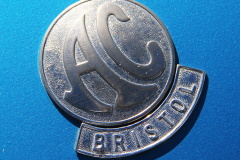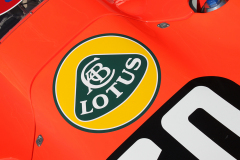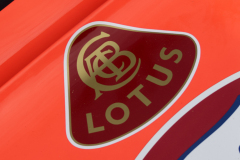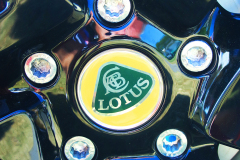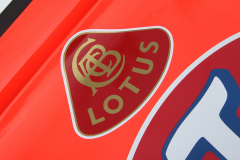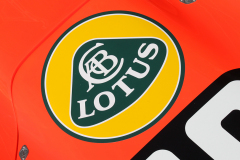AC | Lotus
Lotus, is a British manufacturer of sports and racing cars, based at the former site of RAF Hethel, a World War II airfield in Norfolk, UK. It has been owned since 2017 by Chinese automotive manufacturer, Zhejiang Geely (51%) and Malaysian company Etika Automotive (49%).
Presently organized as Group Lotus plc, the business is divided into Lotus Cars and Lotus Engineering.
The company was originally formed as Lotus Engineering Ltd. in 1952, by engineers Colin Chapman and Colin Dare. The Lotus Mark 1 (an Austin 7 based race car) had been built and raced by Chapman in 1948.
The four letters in the middle of the logo stand for the initials of company founder, Anthony Colin Bruce Chapman.
The company designs and builds race and production automobiles of light weight and fine handling characteristics. It also owns the engineering consultancy firm Lotus Engineering, which has facilities in the United Kingdom, United States, China, and Malaysia.
Lotus was notable for its use of fiberglass bodies, backbone chassis, and overhead twin cam engines, initially supplied by Coventry Climax but later replaced by Lotus-Ford units (Ford block, Lotus head and twin cam valve gear).
Team Lotus (from 1958 to 1994), ran cars in many motorsport series, including Formula One, Formula Two, Formula Ford, Formula Junior, IndyCar, and sports car racing. Team Lotus remained one of the most successful racing teams of all time, winning seven Formula One Constructors’ titles, six Drivers’ Championships, and the Indianapolis 500. Early successes were with the 1953 MKVI and 1954 MK VIII.
Lotus collaborated with Ford on the Ford Cortina Lotus MK I and Mark II a high-performance sports saloon (1963-1966). Lotus also collaborated with Vauxhall Motors in the 1980s to produce the Lotus Carlton, the fastest road going Vauxhall car. In 1981, variants of the 900 series engine were supplied for the Jensen Healey sports car and the Sunbeam Lotus “hot hatchback”.
In 1982, Lotus exchanged intellectual property and applied expertise with Toyota, initially helping to develop the Mk2 Toyota Supra, also known as the Toyota Celica XX. Lotus launched the new Lotus Excel (to replace the ageing Lotus Eclat), using drivetrain and other components from Toyota.
Other collaborations have included the Tesla Roadster which used a Lotus Elise chassis and the infamous Delorean which was completely re-engineering by Chapman.
Lotus’s powertrain department is responsible for the design and development of the 4-cylinder Ecotec engine found in Vauxhall, Opel, Saab, Chevrolet and Saturn cars. Engineering consultancy and engineering development has also been provided to Jaguar, Aston Martin, Volkswagen, Dodge, Spyker, Chevrolet, Isuzu, Nissan, Kia, Hyundai, amongst others.
Early Lotus road cars could be bought as kits, in order to save on purchase tax. The kit car era ended in the late 1960s and early 1970s. The Lotus Elan Plus, Lotus Eclat and Lotus Elite of the mid-1970s were only offered in factory built versions.
The most famous model is the Lotus Seven (1957-72), a simple, lightweight open two seater. The lead character known only as Number Six drove a 1965 Lotus Super 7 in the 1967 TV series “The Prisoner”. Lotus sold the rights in 1972 to Caterham Cars.
The first Elite was an ultra-light two-seater coupé produced from 1958 to 1963.
Lotus found critical and sales success in the 1960s with the Lotus Elan two seater (1962- 1975) – later available in 2+2 coupe format. Another successful Lotus of the late 1960s and early 1970s was the two seater Lotus Europa. In the popular 1960s TV series “The Avengers”, the female lead characters drove Lotuses. Emma Peel had two Lotus Elan convertibles, while her successor Tara King drove a red Elan +2 and a red Europa.
By the mid-1970s, Lotus sought to move upmarket with the launch of the Elite, front engine-rear wheel drive four seater aimed at prosperous buyers. The Elite was the basis for the Eclat, and the later Excel 2+2 coupés.
The Lotus Esprit sports car (1976-2004) replaced the Europa. The Esprit embodied Lotus’s’ ”performance through light weight” mantra, weighing less than 1,000 kg. The James Bond movie ”The Spy Who Loved Me” (1977), featured a Lotus Esprit S1 ( nicknamed “Wet Nellie” which in the movie became not only amphibious but a submarine). “For Your Eyes Only” (1981) featured two Lotus Esprit Turbo’s, especially commissioned for the film.
AC Cars Ltd., formerly known as Auto Carriers Ltd, is a British specialist automobile manufacturer and one of the oldest independent car makers founded in Britain.
The company made its reputation in the post war years with the AC Ace (1953-1963), an open two seater with an alloy body. Followed in 1954 by the AC Aceca hard top coupé version of the Ace.
From 1956, the AC Bristol was also an available option with Bristol Cars’ two-litre 120 bhp straight-six engine.
In 1961 Carroll Shelby needed a car that could compete with the Chevrolet Corvette in US sports car racing, so he approached AC and asked them to use a small block Ford 221 Windsor V8 engine in the Ace chassis, thus producing the first AC Cobra, sold in the US as the Shelby Cobra. From 1962 on, AC exported completed, painted, and trimmed cars (less engine and gearbox) to Shelby who then finished the cars in his workshop in Los Angeles.
AC (in a consortium) has acquired Zenos Cars a British automotive company that produces high-performance, light-weight sports cars. It produces three variants of the Zenos E10 car.
Current AC production includes:
The AC Mark VI is the newest iteration of AC Cars’ classic Ace and Cobra sports cars. It is unable to feature the name “Cobra”, due to the fact Ford Motor Company had trademarked the name. The AC MK VI is the first version of the vehicle to be manufactured in Germany and assembled by Hi-Tech Automotive in South Africa. It’s also the first AC to use a V8 engine and the first to be available in a coupé version featuring gullwing doors.
The AC 378 GT Zagato is a supercar designed by the Italian design company Zagato and built in South Africa by Hi-Tech Automotive.

